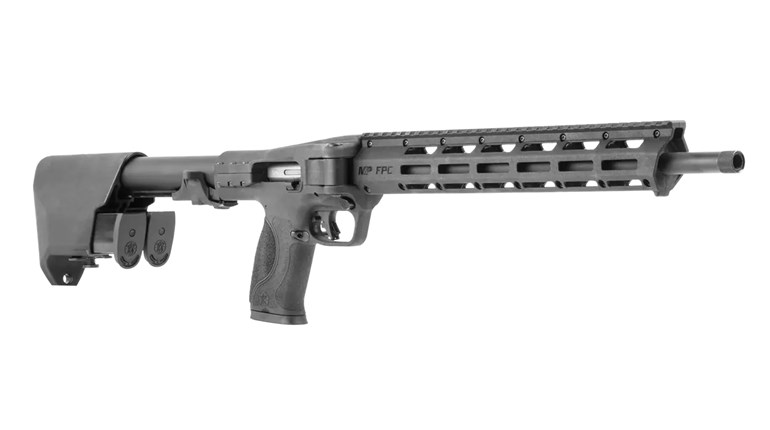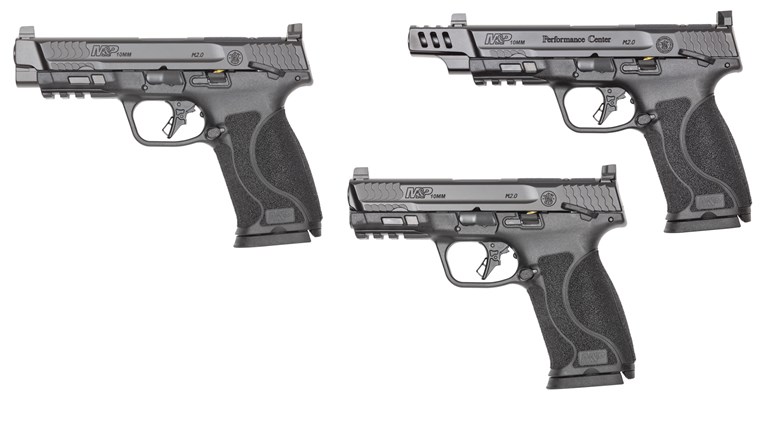
Now, notice the careful wording there: First “lever-action rifle.” Not “first lever-action”—that would go to the Volcanic, the lever-actuated handgun patented by Horace Smith in 1854 using the self-primed “Volcanic” cartridges that allowed firearms to move beyond loose blackpowder and into the world of self-contained ammunition. This technology would eventually find its way over to Winchester, where a slew of lever-action rifles became intensely popular thanks to the post-World War II Western craze in television and cinema.
But, as the expression goes, that was then; this is now. Why would Smith & Wesson, known primarily for its historic line of revolvers and excellent striker-fired M&P semi-automatics, decide to venture into manually operated rifles? Vince Perrault, Smith & Wesson’s director of Brand Marketing, explained this new venture: “Smith & Wesson saw an opportunity, had the capabilities and felt that we could improve the category. Researching the category, we recognized our own history with the first version of a lever-action and thought there were great organic ties worth pursuing. We looked at our revolvers, our history with craftsmanship and found ways to innovate and improve instead of just throwing our hat in the ring.”

As a big fan of the lever-action rifle, this pleases me greatly. For a long time, my lever-action rifles were mostly relegated to used offerings and rimfire chamberings (although, if I’m honest, one of the most wonderful things in the entire shooting world is a brick of .22 LR, a rimfire lever-action rifle and a single-action rimfire revolver, but I digress). Sure, there was the obligatory Marlin in .30-30 Win.; perhaps a Rossi in .357 Mag., but for the most part, lever-action rifles were barely an afterthought. Bolt-action rifles were plentiful for long-range endeavors and hunting; AR- and AK-pattern rifles were the default defensive guns. Everything else, well …
This has changed in recent times. We’ve seen companies like Bond Arms, known for its break-open derringers, introduce a lever-action rifle that takes AR-15 magazines. POF-USA has a lever-action, pistol-caliber carbine. Aero Precision, one of the bigger names in the AR-15 parts world, launched a lever-action, as did its sister company Stag Arms (another big name in the AR universe). Then, Smith & Wesson weighs in with the 1854. Whatever your thoughts might be on the sudden influx of lever-action rifles, when a giant like Smith & Wesson puts its manufacturing weight behind something, it bears notice.
Currently, there are two variants of 1854. There’s a bespoke model with gorgeous blue steel and high-quality walnut, which is available in limited quantities and at a premium price. Had that been the only model offered, one might be forgiven for thinking that Smith & Wesson was cashing in on the latest fad, the latest shiny bauble in the firearm world, to garner attention and accolades. Except, it’s not the only model. The other 1854, the subject of this review, is the stainless steel and polymer model. It’s offered at an eminently reasonable price compared with other centerfire lever-action rifles, and it’s built rock-solid for the long haul. Both are chambered in .44 Mag., an interesting choice for a company’s premier foray into lever-action rifles. I’d wager that most would be expecting either .30-30 Win. or .45-70 Gov’t, yet Smith & Wesson opted for the big-bore revolver round, because, as Grant Dubuc, director of Product Innovation for Smith & Wesson, explained, “We wanted to test with a powerful caliber to start, in order to prove out life-of-design and have the basis to pivot from there if needed.” Makes sense to me.

Let’s check out this new 1854, starting with the furniture and finish. Certainly, we all love the look of a highly polished wood stock paired with a deep-blue finish. Polymer furniture and stainless steel are utilitarian, and while we recognize the appeal of beautiful things, we also appreciate a tool that can be used in all sorts of weather, without worrying incessantly about the furniture getting dinged or the finish aging prematurely because of the environment. Smith & Wesson approached the 1854 with the mindset of utility first. That’s a bold prospect when it comes to a lever-action gun, but think about it: What percentage of Smith & Wesson revolvers are stainless steel versus a blued finish? How many feature rubber stocks rather than wood? The 1854 maintains the same durability and usability as the revolvers for which the company is famous. That’s just smart branding.
Aesthetics aren’t the only modern aspect of the 1854, though. Up on top, there’s a Picatinny rail to which one can attach a red-dot optic or low-power variable optic. At the muzzle, there’s an 11/16x24 tpi-threaded barrel to accept a sound suppressor or muzzle device. On the polymer fore-end are three M-Lok attachment slots for lights, lasers, sling mounts or any other attachment you’d care to add to your defensive rifle. Suppressor-ready, able to add lights and easy to add an electro-optic or low-power scope? That sounds like, well, every other modern rifle out there.
There’s no getting around the manual operation, of course. For someone like me who’s used to the semi-automatic operation of the AR-15, there’s a bit of a reset needed (I’m the same with bolt-action rifles, if I’m honest). Working a lever action does require you to break your firing grip which, if your rifle experience centers on basic defensive-carbine work, may seem anathema to everything you’ve learned and practiced. Unlike the bolt-action rifle, though, you’re not completely coming off the rifle, just moving the lever down and back. In any case, don’t sweat it; there’s something in our DNA that loves a lever-action. I know it. Once you work the lever a handful of times, it’s second nature. And, you may just be surprised how fast you can run a lever-action rifle.

Speaking of the 1854’s operation, I’ll admit to a moment of stupid with regard to the safety. I believe I’ve stated I’m more familiar with the AR-15, yes? Well, with an AR, when the safety’s on, the trigger won’t budge. Same with pump-action shotguns like the 870 or 590—if the safety is on, the trigger won’t move. It’s instant feedback that, yes, dummy, take the safety off if you want the gun to make loud noises. The safety on the 1854, however, prevents the hammer from making contact with the firing pin. This means that you can pull the trigger, the hammer will fall and you’ll hear naught more than click. It’s not a good thing or a bad thing; it’s just different. If you’re used to a safety that prevents a trigger from moving at all, it might take you a moment or two to figure out what’s going wrong. Or, you could be on camera, staring at the gun like a duck in thunder, when the helpful Editor-in-Chief of American Hunter reminds you to take the safety off.
This difference in operation does bring up a serious question. Why opt for a lever-action rifle? I’m going to throw the most obvious reason out there first: Fun. There’s just something about a lever-action rifle that makes you feel like Chuck Connors in “The Rifleman” (kids, ask your parents. Or maybe at this point, grandparents). Ringing steel on an open-air range with a lever-action rifle is a heck of a lot of fun. While the .44 Mag. chambering is more expensive than your average 9 mm, other lever-gun options like .30-30 Win. and .45-70 Gov’t are both even pricier as well as harder on steel and other reactive targets. If .44 Mag. is a little too much, the 1854 can also chamber and fire .44 Spl., much like a .44 Mag. revolver.
Second, and continuing on the .44 Mag. chambering, there’s just something about the sound of a .44 Mag. round coming out of a rifle. I distinctly remember, many, many years ago at my local public range (which was pistol-caliber only), a gentleman came in with a lever gun in .44 Mag. The sturm und drang of the magnum cartridge rattled the Plexiglas separating the range from the gun shop, and the flame shooting out of the barrel was impressive. You’re definitely going to make an impression on the firing line—and you don’t need to have an obnoxious muzzle brake knocking your neighbor’s gear off the bench next to you to do so.
 Is the 1854 a viable home-defense option? You bet it is. Out of the 19-inch barrel of the 1854, a 240-grain .44 Mag. round can reach muzzle energies of 1,200 ft.-lbs. That’s about half the energy of a .308 Win.—and more than triple that of the mighty .45 ACP. Yeah, that’ll do the trick, indeed. Here’s the kicker, though: Even the stoutest of .44 Mag. rounds is quite controllable out of the 6-pound, 12.8-ounce carbine. Everyone thinks of Dirty Harry’s Model 29 and the “most powerful handgun in the world” line (which it wasn’t, not even at the time of “Dirty Harry”), but that was out of a handgun. Out of a rifle, the .44 Mag. is quite controllable, and can even venture into “fun” territory. And again, you can substitute the less powerful .44 Spl. for practice or plinking and have a grand-old time without beating up your shoulder. Just be sure to run the lever with authority—the shorter .44 Spl. cases won’t clear the ejection port otherwise.
Is the 1854 a viable home-defense option? You bet it is. Out of the 19-inch barrel of the 1854, a 240-grain .44 Mag. round can reach muzzle energies of 1,200 ft.-lbs. That’s about half the energy of a .308 Win.—and more than triple that of the mighty .45 ACP. Yeah, that’ll do the trick, indeed. Here’s the kicker, though: Even the stoutest of .44 Mag. rounds is quite controllable out of the 6-pound, 12.8-ounce carbine. Everyone thinks of Dirty Harry’s Model 29 and the “most powerful handgun in the world” line (which it wasn’t, not even at the time of “Dirty Harry”), but that was out of a handgun. Out of a rifle, the .44 Mag. is quite controllable, and can even venture into “fun” territory. And again, you can substitute the less powerful .44 Spl. for practice or plinking and have a grand-old time without beating up your shoulder. Just be sure to run the lever with authority—the shorter .44 Spl. cases won’t clear the ejection port otherwise.
Aside from that, on the range nothing outside of the ordinary was observed. More than 200 rounds of .44 Mag. and .44 Spl. went through the 1854, with no failures other than the aforementioned ejection of .44 Spl. Accuracy was about 3 MOA across all ammo, and considering this is a pistol-caliber, lever-action rifle, that’s about right—it’s not going to be anyone’s first choice for PRS competition, but that’s not what it’s made to do. Whether you’re ringing steel at carbine ranges or looking for something to defend the homestead, the 1854 will serve that role willingly.
In the end, lever-action rifles are a niche item. For those who fancy them, Smith & Wesson’s Model 1854 represents a solid, working carbine. It’s dependable, built tough and has modern touches that make it suitable for use in home-defense situations. What does the future hold for the Smith & Wesson lever-action line? While the folks I talked to were pretty tight-lipped about future variations, whether alternative barrel lengths or chamberings, it’s not hard to imagine some additional exciting lever-actions from Smith & Wesson in the future.


































